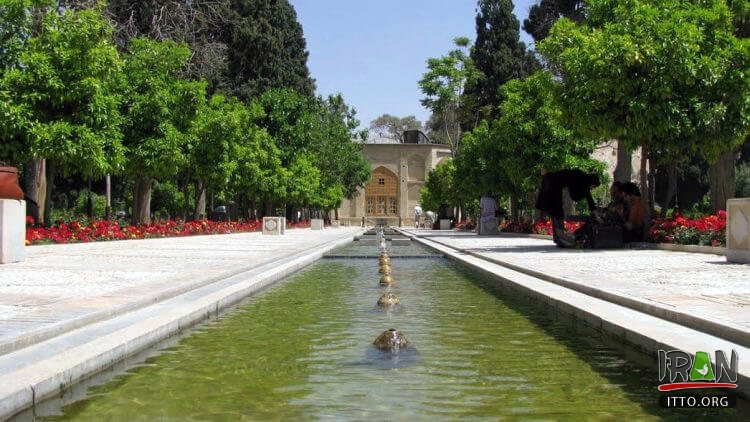Jahan Nama Garden is one of the most famous tourist attractions in city of Shiraz, which probably dates back to Zandieh era. This garden is located at entrance of Shiraz city. Most of the present designs have been made in the 18th century. Establishing Jahan Nama Complex with traditional interior design increases the beauty and harmony of this region. It is located on Hafez Street and is being fed with Rokni river.
In a classic Persian garden arrangement, four broad avenues, bordered with orange trees, cypresses and roses converge on an octagonal stone pavilion at the centre. This 18th century pavilion contains an internal fountain pool from which, once restoration is complete, water will flow down steep chadars to pools on each side. In the centre of one of the four avenues from the central pavilion is a long rill, lined with 64 fountains, which stretches nearly to the garden wall.
It was an important garden in Safavid Era but after the extinction of the Safavid Dynasty, this garden almost destroyed. In the reign of Karim Khan Zand, this garden was renovated and they built a mansion in it. They also fenced the garden and they organized the structure of the plantings around the mansion. In Qajar Era, the garden hosted guests of the government.

In a classic Persian garden arrangement, four broad avenues, bordered with orange trees, cypresses and roses converge on an octagonal stone pavilion at the centre.
Jahan Nama Garden, like most gardens in Iran, has three main features:
1. it is located along a ditch,
2. it is surrounded by tall walls,
3. It has a summer mansion with a swimming pool
Main building of gardens is a mansion known as “Kolah Farangi”, which is exactly in middle of garden. This mansion is a four-porch mansion with two floors. Facade of Kolah Farangi of this garden is made of brick. This mansion is without tile and painting. Of course, it might have some decoration, however, by passing time, these decorations were disappeared.
The number 8 is a theme:
8 cypresses on each of the main paths, 8 sections to the long rill, 8 fountains to each section etc. Some very old cypresses survive. There are large areas of colourful planting in geometric flower beds yellow and purple pansies, red, purple and white stock. A pergola is being developed over one avenue path. Many benches are provided for visitors.
In April the air is heavy with the scent of orange blossom. Beyond the dark cypresses lining the arcaded boundary walls are views to the rocky Zagros mountains - a nearby hill is topped by the cupola of a dervish shrine.

